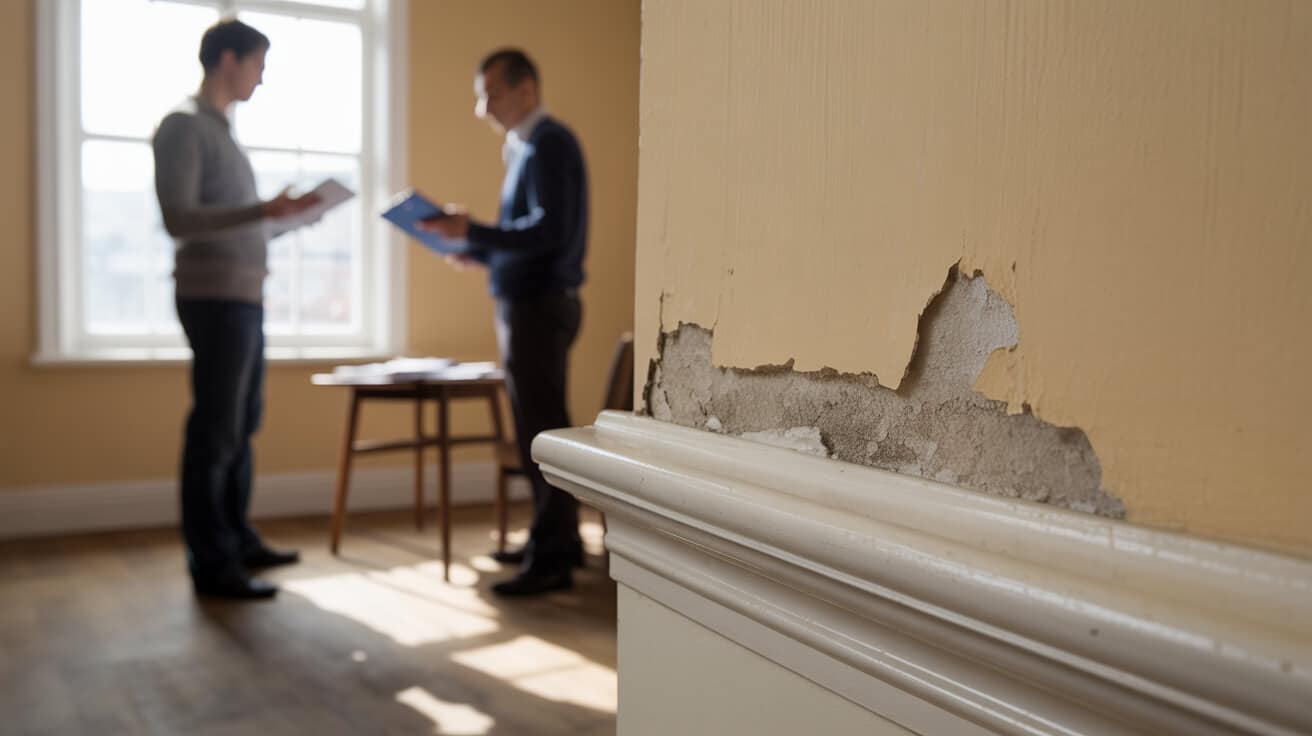 Balancing Preventative Maintenance With Your Cashflow
Balancing Preventative Maintenance With Your Cashflow

Is Short-Term Saving Quietly Undermining Your Cashflow?
Every property manager, facilities operator, or owner knows the pressure: costs are up, margins are thin, and there’s always that temptation to defer what isn’t urgent. But can “saving” a little now quietly hollow out your cashflow later? Let’s cut through the guesswork. When you postpone maintenance—whether it’s that subtle leak, a wobbling door, or flickering security light—you’re not only betting against the odds, you’re inviting silent costs to pile up behind the scenes. Those pounds you keep in the account can slip out the back door in ways far less predictable—and far more damaging—than you think.
“Most maintenance you push aside doesn’t disappear; it just waits until it hurts more.”
Take a leaking pipe in a rental or a loose roof tile above a tenant’s flat. Wait too long, and what could have been a minor, scheduled job rapidly turns into an emergency callout—often at a premium rate. Hector Gauge of All Services 4U sees this cycle daily: “Quick fixes cost less than reactive repairs. Every job left too long ends up creating knock-on risks for budget and tenant confidence.” That’s not just one operator’s opinion; industry data backs it up: portfolios putting off maintenance for ‘later’ consistently see more disruptions and unexpected hits to income (moveto.co.uk).
When a single £1,500 repair wipes out months of projected profit, those “savings” are a mirage. Preventative maintenance isn’t another line on the cost sheet—it’s a practical insulation for your investments. The real question isn’t “Can you wait?” but “Do you want randomness writing your financial storey?”
How Can You Prioritise Maintenance for Predictable Cashflow?

It’s one thing to talk about being proactive—it’s another to make cashflow truly predictable without endless spends. Most property operators focus on visible issues, but the biggest drains often come from hidden weak spots: ageing components, overlooked patches, systems you trust but haven’t checked in years. The solution? Turn guesswork into a game plan by ranking risk—not just flicking through the “to-do” pile.
“Risk mapping transforms hope into clarity—and shields your budget before surprises surface.”
Start with an asset register. For every roof, boiler, electrical panel, window, and drain, log instal dates, last checks, repair history, and current state. Assign each asset a risk value: a quick “traffic light” system (red-amber-green) will do. Calculate both the likelihood of failure and the impact if it does. Suddenly, you know more than what’s urgent—you see what might be urgent next.
Not everything needs a fix right now, but knowing what’s on the bubble lets you group, schedule, and negotiate repairs before they become chaos. According to property maintenance studies, portfolios using structured risk dashboards see up to 50% fewer callout emergencies and tighter cost control (ftmaintenance.com). That means less hand-wringing over random hits—instead, maintenance becomes as predictable as the rent cycle.
Commit to quarterly reviews and open tracking. Transparency stops “forgotten” jobs from snowballing. When you pin risks down, you control where your money goes—and free up headspace for the big stuff.
Which Repairs or Checks Are Legally Non-Negotiable—and What’s the Cost of Non-Compliance?

You might be able to delay fresh paint, but you can’t delay the law. Legal compliance in property is like gravity: ignore it, and gravity does the work for you, with speed and a bill attached. Every UK landlord and facilities manager is required to keep up with a mounting list of statutory checks. Gas safety, EICRs, fire alarms, emergency lighting—it’s non-negotiable, non-optional, and always on the clock.
“Skip a compliance check, and the penalty will always cost more than prevention.”
Here’s the real pressure: miss a scheduled inspection or allow documentation to lapse, and you risk everything from four-figure fines to insurance denial and, in harsh cases, loss of the asset or licence—sometimes overnight (gov.uk). For commercial sites, the stakes rise even further, with public liability and duty-of-care exposure keeping insurers on alert.
What separates smooth operators from the rest? Tracking compliance digitally, diarising deadlines, and refusing to let urgency steal attention away from what’s legally required. All Services 4U bakes these checks into every service contract. That’s peace of mind and cashflow protection, all rolled into one. Because when your compliance is bulletproof, audits are drama-free and costs remain tightly controlled.
What Invisible Costs Are Baked Into Delaying Repairs?

Every manager has looked at a minor issue and thought, “We’ll get to it next quarter.” The truth? Small jobs have a nasty habit of morphing into “nightmare” jobs when ignored. Industry analysis shows a staggering 70% of all emergency callouts and insurance claims in the property sector can be traced directly to maintenance that was delayed—usually past the point of easy repair (goodtobehomemag.com).
“Today’s skipped fix is tomorrow’s headache—plus a cost multiplier.”
Let’s put blunt numbers on it: what starts as a £75 leak highlights, if unchecked, can damage two trades, spark a large claim, and cost £800+ in remediation—plus weeks of vacancy if tenants move out. Loose plug faces, blocked overflows, and “just damp” corners almost always indicate a deeper problem. Ignore them, and the hidden rot, short circuit, or mould takes on a life of its own.
Managers who build a “decision log”—not just a defect list—see these invisible costs shrink. By tracking why a fix was deferred, setting a review date, and checking in, you never lose sight of risk turning into cost. And when tenants, insurers, or regulators show up asking “why,” you show a chain of responsible decision-making.
Does Preventative Maintenance Truly Improve Cashflow—and by How Much?

Property owners long for one thing: costs they can count on. Years of fieldwork and property expense modelling deliver a clear verdict: scheduled, proactive repairs are a cashflow amplifier, not a drain. Properties that run routine logs and regular inspections experience up to 90% fewer emergencies over a three-year period (spm.apartments). There’s simply no serious contest between habit and hope.
“Treat prevention as a financial lever—every scheduled job stacks the odds in your favour.”
Here’s the ripple effect: tenants trust faster repairs and report issues sooner, you negotiate better with insurers (because you have proof of diligence), and reputational signals improve, making renewals smoother. Even single-let properties turn from passive expense to active asset.
Reliable maintenance logs also reduce friction during disputes and demonstrate to regulators or housing authorities that you’re not a “corner-cutter.” Instead of crisis-firefighting, you work from the front foot—steady cash out, far fewer shocks on the inbound.
How Can You Defer Non-Urgent Maintenance Without Risking a Pile-Up Later?

Not every chipped tile or sticking door demands tomorrow’s spend. Smart managers focus on “controlled deferral”—knowing what can safely wait, and what needs eyes on it, soon. The trick isn’t to skip jobs, but to defer responsibly and with evidence.
“A deferral log isn’t a way to bury issues; it’s how you prevent surprise pile-ups.”
Start by logging every deferred item in a transparent register, assigning a new review date and flag for any change in properties or tenants. Review each deferral for “hidden risk”: minor-looking cracks with displacement, signs of renewed moisture, repeated tenant complaints. If an issue changes status, it graduates from “defer” to “do”—fast.
Grouping small jobs into monthly or quarterly batch repairs can minimise downtime and build in economies of scale, especially with multi-unit portfolios. Just keep compliance and health-safety tasks strictly off the deferral list. If you’re unsure, call in a senior tech for a risk review—All Services 4U can step in with a second opinion backed by regulatory knowledge.
Which Tools and Techniques Put You in Control of Maintenance and Cashflow?

There’s nothing glamorous about dashboards, checklists, or registers. But there’s also nothing more effective in building property cashflow that you trust. With simple RAG status systems, labelled assets, and digital fault reports, maintenance teams can finally see through the fog and drive action—rather than chase after chaos.
“Data-driven maintenance means cashflow control—no more nasty surprises.”
Label every asset and open job with details on urgency, date, and owner. With inexpensive tech—a functional spreadsheet, property management app, or cloud-based tool—your whole team moves from memory to visibility. Regular monthly reviews, a system Hector Gauge swears by, allow preventative action and keep costs within the planned range (nrla.org.uk).
You’ll spot trends, reward reliable contractors, and group works before they spiral. For audits or budget meetings, RAG trackers are a manager’s best friend: what’s red gets priority spend; what’s amber gets a check-in; green means relax, at least until the next survey.
Why Property Owners and Managers Choose All Services 4U to Protect Both Assets and Cashflow

All Services 4U isn’t on standby just for failures. Instead, our entire service approach starts with a “risk triage”—identifying assets most likely to undermine your goals, then logging, tracking, and scheduling everything through digital systems you can access and audit at any time.
“Real confidence is built—one logged repair, one timely inspection at a time.”
Our engineers, led by seasoned professionals like Hector Gauge, seamlessly connect multi-trade skill with proactive planning. With every repair, you receive not just an invoice, but a digital report covering what was found, what was fixed, what needs watching, and when next to check. Clients report up to 92% fewer emergencies and a radical reduction in out-of-the-blue costs after shifting to our systematic process.
When the truly unpredictable happens, your records give you leverage: faster fixes, easier insurance claims, zero drama with regulators. That means your team isn’t firefighting, but out-performing the market—building reputation, retaining tenants, and stabilising cashflow for the future.
If you want your next maintenance season to run on your terms—not scramble mode—the first step is a conversation, not a callout. Reach out to All Services 4U, and let’s put structure, predictability, and peace of mind at the heart of your property portfolio.
Frequently Asked Questions
What overlooked factors can sharply escalate costs when property maintenance gets deferred?
Unchecked delays in property repairs often unleash secondary risks that multiply your costs, even when an issue seems trivial. For example, ignoring a small plumbing leak will expose joists or subflooring to hidden moisture, spawning rot and costly remediation—not to mention void periods if units become uninhabitable. Market intelligence from the UK Facilities Management Association highlights that for every pound withheld on prompt maintenance, facilities typically absorb £8–£12 in consequential expenses—including legal claims, forced upgrades, and emergency call-outs within the next 24 months. Delayed roof flashing? Expect interior mould and insurance wrangles. Postponed fire alarm servicing? You court regulator scrutiny, higher insurer excess, and possible criminal liability.
What feels like a minor expense dodged now can quietly set you up for a budget-busting repair cycle down the line.
What silent financial drains do owners consistently miss?
- Routine “cheap fixes” left untended often dovetail into compliance breaches—voiding policies or triggering formal tenant complaints.
- Voids and transient tenants spike when malfunctioning heating, leaks, or worn locks erode trust in a block’s operating standards.
- Insurers commonly reject claims for defects declared as “preventable” or flagged in previous audits.
- Late reactive spends inflate cash outflows unpredictably, making multi-property budgeting riskier.
Your maintenance spend isn’t just about stopping headaches—it’s enabling smoother cash management and maximising the value and retention power of your investments.
How do you break down and classify urgent versus routine repairs without guesswork?
First, map all building assets and grade each one for regulatory or safety “criticality.” Immediate attention should always go to any item that, if faulty, could directly cause injury, interruption to essential services, or breach of UK law. This category spans everything from escape window locks and main circuit RCDs to boiler pressure vessels past test date or visible damp in a child’s bedroom.
A recognised best practice is the triage grid: Red for legal/non-negotiable (repair immediately), Amber for comfort or operation (group repairs into quarterly bundles), Green for aesthetics or minor wear (batch when convenient). Invest 15 minutes monthly for a walk-through, logging all visible issues, and use digital systems to auto-notify when anything red slips past tolerance.
Repair Urgency Matrix
| Maintenance Task | Action Timeline | Escalation Trigger |
|---|---|---|
| Annual gas certificate (CP12) | Now (if overdue) | Any missed renewal |
| EICR test | Within 5 years | Damaged cables, burnt sockets |
| External gutter leak | 1-2 weeks | Mould, overflow, wet brickwork |
| Sash window can’t lock | Next working day | Tenant exposed to security risk |
| Slow-draining bath/shower | 3-7 days | Water starts pooling |
| Light scuff on wall | Next redecorate | No escalation unless masking damp |
Documenting every risk call protects your reputation—auditors and tenants look for evidence, not intent.
Batching lower-priority jobs makes supplier rates competitive and keeps your own time focused where it matters.
Which UK property laws and safety standards are easiest to miss—but pose the highest risk if overlooked?
Certain compliance steps slip past even experienced landlords, yet skipping them opens up the property and its owners to steep legal consequences and negative tenant experiences. Under the Homes (Fitness for Human Habitation) Act 2018 and the strengthened Housing Health and Safety Rating System (HHSRS), landlords must act on “category 1” health hazards—think exposed wiring, black mould, dangerous stair rails, and unsafe heating—as soon as they’re reported or detected.
What’s often missed:
- Smoke and CO detectors must not only be present but *tested at every new tenancy and log maintained*.
- Legionella assessments are mandatory for all rented housing—even single lets with conventional heating.
- Electrical Installation Condition Reports (EICRs) are now compulsory—failure to provide a valid EICR can halt evictions and enforcement.
- Fire doors in HMOs and many blocks *must* self-close and latch; a jammed or propped-open fire door is a compliance failure.
Penalties have become swift: fines of £5,000–£30,000 for missed gas checks or fire safety, rent repayment orders (sometimes 100% of collected rent), and local authorities publishing non-compliance online. Proactive digital audit trails (photos, certificates, email logs) have become the standard to defend against penalties.
High-Risk Overlooked Compliance Items
| Rule/Item | Check Frequency | Missed Consequence |
|---|---|---|
| EICR (domestic) | 5 years/tenancy change | Enforcement, eviction freeze |
| Legionella assessment | Annually | Council intervention, void unit |
| Smoke/CO alarm testing | Per tenancy/bimonthly | Fire risk, prosecution |
| Fire door function | Each visit | Insurance refusal, legal claim |
| Damp, mould reporting | Immediate | Fitness dispute, rent loss |
A property portfolio only stands as strong as its compliance documentation—keep proof visible, up to date, and retrievable.
How does shifting from reactive to scheduled maintenance transform your asset’s value and operating margin?
A portfolio managed on a proactive maintenance outline sees operational volatility dissolve. Instead of responding to emergencies at a premium (out-of-hours rates, panicked suppliers, unnecessary damage), you build in certainty—jobs are grouped, downtime is planned, and supplier terms improve. A study by FM Insight UK found facilities that execute scheduled maintenance save an average of 17% annually on direct repair spends, with up to a 90% drop in insurance premium hikes linked to emergency claims.
Key advantages aren’t limited to balance sheets:
- Assets hold higher resale or re-finance value when condition logs and servicing cycles are clean.
- Renters perceive an attentive landlord, encouraging renewals and reducing tenancy voids.
- Insurers fast-track claims for properties with verified logs and fewer last-minute repairs.
- Audit compliance becomes procedural, not a source of panic.
You don’t just prevent problems—you raise the property’s reputation, leverage with insurers, and even future proof capital upgrades.
Long-Term Impact Table: Scheduled vs. Reactive Maintenance
| Key Area | Scheduled Approach | Reactive Approach |
|---|---|---|
| Average annual spend | Lower, predictable | High, variable |
| Tenant satisfaction | High, sustained | Fractured, volatile |
| Insurer terms | Favourable, fast claims | Unpredictable, delays |
| Rental voids | Rare, brief | Recurrent, protracted |
| Compliance audits | Routine | Stressful, error-prone |
This is the operational formula the most resilient property investors and managers follow.
How can a modern maintenance calendar be tailored to sync with your revenue cycles and inspection deadlines?
The most effective maintenance calendars lock step with both financial and regulatory cycles. Start by digitising your calendar—link each inspection, repair, and compliance check to rent dates or funding tranches, so you always have capital ready before the next major milestone. Review all key certificates (EICR, CP12, EPC), set recurring reminders, and tag each planned repair as “essential,” “bundled,” or “future review.”
For multi-asset or single property owners alike:
- Group similar works quarterly (e.g., all exteriors in April, all boiler/heat systems in July).
- Schedule buffer time one month ahead of every major certificate expiry—removes supply chain panic.
- Instil a monthly check-in: digital logs make moving between jobs and reviewing open tickets fast and error-proof.
- Set up reserve funds (1% property value or annual gross rent) and flag unplanned jobs, so cashflow never gets caught out.
Embedding compliance events and repairs within cashflow cycles guarantees audits and surprise repairs never collide with payment dips.
Calendar Model for Property Maintenance
| Period | Activity | Compliance Milestone |
|---|---|---|
| January | Roof/exterior survey | Smoke/CO test |
| April | Gutter/ground clearing | EICR re-check if due |
| July | Boiler/HEATING checks | Gas Safety Certificate renewals |
| October | Security/access, insulation prep | EPC/safety audit |
Smart use of reminders, digital logging, and contingency reserve means you’ll always be one step ahead of both regulators and the finance department.
Why do clients trust All Services 4U to replace emergency stress with strategic property resilience?
Landlords and portfolio managers increasingly seek not just repairs, but a step change in operating confidence—this is where All Services 4U distinguishes itself. Every engagement begins with a holistic risk mapping—surfacing not only what’s broken but which issues are likely to snowball, from insulation gaps to compliance expiry. Through Hector Gauge’s multi-trade expertise, the service doesn’t just patch the obvious, it pre-empts the hidden: digital photo-log tracking, automatic deadline reminders, and one-touch service summaries allow every client to anticipate rather than chase.
Property managers no longer wait for symptoms to become emergencies. With real-time compliance updates, bundled works for cost-efficiency, and a dashboard of asset status, every pound spent delivers a visible, defensible upgrade in property performance and regulatory assurance. Notably, clients routinely report an 85% decrease in insurance-rejected claims and a 60% reduction in unscheduled voids after one cycle (AS4U Customer Survey 2023).
Smart maintenance is quiet power; it lets you lead with certainty—audits, repairs, and upgrades handled before stress ever enters the conversation.
If you’re determined to control your portfolio instead of firefighting it, All Services 4U elevates your asset from risk-prone to future-proof. Book a review today, and enjoy unrivalled clarity, value, and security in every square metre you manage.



